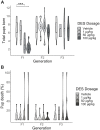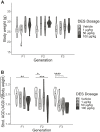Prenatal exposure to diethylstilbestrol has long-lasting, transgenerational impacts on fertility and reproductive development
- PMID: 37471692
- PMCID: PMC10464516
- DOI: 10.1093/toxsci/kfad066
Prenatal exposure to diethylstilbestrol has long-lasting, transgenerational impacts on fertility and reproductive development
Abstract
Significant decreases in fertility have been observed over the past 50 years, with female conception rates dropping by 44% and male sperm counts decreasing by over 50%. This dramatic decrease in fertility can be attributed in part to our increasing exposure to endocrine disrupting chemicals (EDCs). Diethylstilbestrol (DES) is an estrogenic EDC that was prescribed to millions of pregnant women between 1940 and 1970 and resulted in detrimental reproductive effects in the offspring that were exposed in utero. Women who were exposed to DES in utero experienced higher rates of infertility, pregnancy complications, and reproductive cancers. Alarmingly, there is evidence to suggest that these effects may persist in the grandchildren and great grandchildren of exposed women. To define the transgenerational reproductive impacts in females following exposure to DES, gestating mice were exposed to DES and the effects monitored in the female descendants across 3 generations. There was a trend for reduced pregnancy rate and fertility index seen across the generations and moreover, the anogenital distance (AGD) was significantly reduced up until the third, unexposed generation. The onset of puberty was also significantly affected, with the timing of vaginal opening occurring significantly earlier in DES descendants. These results indicate a transgenerational effect of DES on multiple reproductive parameters including fertility, timing of puberty, and AGD. These data have significant implications for more than 50 million DES descendants worldwide as well as raising concerns for the ongoing health impacts caused by exposures to other estrogenic EDCs which are pervasive in our environment.
Keywords: DES; EDC; fertility; transgenerational.
© The Author(s) 2023. Published by Oxford University Press on behalf of the Society of Toxicology.
Figures






References
-
- Al Jishi T., Sergi C. (2017). Current perspective of diethylstilbestrol (DES) exposure in mothers and offspring. Reprod. Toxicol. 71, 71–77. - PubMed
-
- Arango N. A., Donahoe P. K. (2008). Sex differentiation in mouse and man and subsequent development of the female reproductive organs. In StemBook (The Stem Cell Research Community, Ed.). Harvard Stem Cell Institute, Cambridge, MA. - PubMed
-
- Aris A. Z., Shamsuddin A. S., Praveena S. M. (2014). Occurrence of 17α-ethynylestradiol (EE2) in the environment and effect on exposed biota: a review. Environ. Int. 69, 104–119. - PubMed
-
- Barbour H. G., Trace J. (1936). Standard metabolism in the white mouse. Am. J. Physiol. 118, 77–86.
-
- Boivin J., Bunting L., Collins J. A., Nygren K. G. (2007). International estimates of infertility prevalence and treatment-seeking: potential need and demand for infertility medical care. Hum. Reprod. 22, 1506–1512. - PubMed
Publication types
MeSH terms
Substances
LinkOut - more resources
Full Text Sources
Miscellaneous

